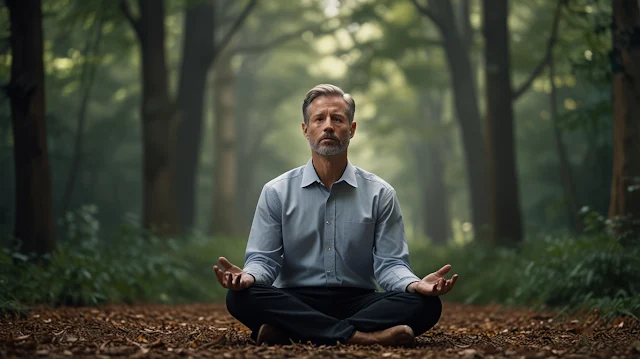The Ultimate Guide to Achieving Mental Peace: Science-Backed Lifestyle Strategies
Table of Contents
- Introduction: Why Mental Peace Matters More Than Ever
- The Science of Mental Peace
- Daily Habits for Sustainable Calm
- Digital Detox & Mental Clarity
- Emotional & Social Well-Being
- Quick Stress-Relief Techniques
- Conclusion: Your Path to Lasting Peace
- FAQs
Introduction:
In today’s fast-paced, hyper-connected world, mental peace isn’t just a luxury—it’s a necessity. Chronic stress, digital overload, and societal pressures make it harder than ever to maintain emotional balance. Yet, research shows that cultivating mental peace reduces anxiety, boosts resilience, and even enhances physical health.
 |
| Peace Powers Clarity |
Why Mental Peace Matters More Than Ever
When stressed, the amygdala (the brain’s "alarm system") overrides rational thinking. Mental peace strengthens the prefrontal cortex, improving decision-making and emotional control. Habits like meditation and gratitude physically rewire the brain for calm, reducing activity in stress-prone regions. Mental health addresses clinical conditions and may require therapy or medication, while mental peace focuses on daily harmony and resilience, built through lifestyle habits.
 |
| Calm Rewires Brain |
The Science of Mental Peace
When stressed, the amygdala (the brain’s "alarm system") overrides rational thinking. Mental peace strengthens the prefrontal cortex, improving decision-making and emotional control. Habits like meditation and gratitude physically rewire the brain for calm, reducing activity in stress-prone regions.
 |
| Rise With Calm |
Morning Routines for a Peaceful Mind
Starting your day on a positive note can set the tone for the rest of the day. A few minutes of sunlight and a quick gratitude journal can make a big difference. Writing three things you’re grateful for reduces stress by 28%. Pairing this with a breathing exercise, like the 4-7-8 technique, activates the parasympathetic nervous system, promoting calm.
 |
| Eat For Balance |
Mindful Nutrition for Emotional Balance
What we eat affects how we feel. Choosing foods that support our gut health, such as fermented foods and omega-3s, and reducing stimulants like caffeine, can help keep our emotions in check. Moving our bodies is a powerful way to calm our minds. Whether it’s yoga, Tai Chi, or just a walk in the park, physical activity can help us feel more centered and less stressed. Just 20 minutes of yoga daily lowers cortisol by 30%.
 |
| Move for Peace |
Movement as Medicine
Moving our bodies is a powerful way to calm our minds. Whether it’s yoga, Tai Chi, or just a walk in the park, physical activity can help us feel more centered and less stressed. Just 20 minutes of yoga daily lowers cortisol by 30%.
 |
| Screens Drain Peace |
The Toll of Screen Overload
Our screens can be both a blessing and a curse. While they keep us connected, they can also keep us stressed. Taking breaks from screens, especially before bed, and setting boundaries around social media use can help us feel more relaxed and focused. Limiting social media use to 30 minutes a day reduces FOMO and boosts inner peace. Enabling grayscale mode on your devices and scheduling "tech-free hours" can reduce engagement and improve mental clarity.
Action Plan
- Enable grayscale mode to reduce app engagement.
- Schedule "tech-free hours" (e.g., 7–9 PM).
 |
| Connect With Care |
Building Healthy Relationships
Our relationships and alone time are both crucial for our mental peace. Surrounding ourselves with positive, supportive people and learning to let go of grudges can make a huge difference. At the same time, taking time for ourselves and connecting with nature can help us recharge and find clarity. Spending two hours a week in nature lowers stress hormones.
 |
| Embrace Quiet Moments |
The Power of Solitude
Taking time for ourselves and connecting with nature can help us recharge and find clarity. Spending two hours a week in nature lowers stress hormones.
 |
| Calm Instantly Anytime |
Quick Stress-Relief Techniques
Sometimes, stress can hit us hard and fast. Having quick techniques like grounding exercises and box breathing can help us stay calm in the moment. The 5-4-3-2-1 grounding exercise—naming five things you see, four things you touch, three things you hear, two things you smell, and one thing you taste—is ideal for panic attacks or overwhelm. Box breathing, a technique used by Navy SEALs, involves inhaling for four seconds, holding for four seconds, exhaling for four seconds, and holding again for four seconds, repeated four times to reset the nervous system.
FAQs
Q1: How long does it take to see results from these strategies?
A: Results can vary, but many people start feeling calmer within a few weeks of adopting these habits.
Q2: Can I practice these strategies if I have a busy schedule?
A: Absolutely! Even small changes, like a 10-minute morning routine or a short walk, can make a big difference.
Q3: What if I find it hard to stay motivated?
A: Start with one small change and build from there. Celebrate your progress and be kind to yourself.
Q4: How can I involve my family in these practices?
A: Share your goals with them and find activities you can do together, like family yoga or nature walks.
Q5: Are there any apps or tools that can help?
A: Yes, there are many apps for meditation, gratitude journaling, and tracking your progress. Some popular ones include Headspace, Calm, and Insight Timer.
Conclusion: Your Path to Lasting Peace
Mental peace isn’t about eliminating stress—it’s about building emotional resilience through intentional habits. Start small: adopt one morning ritual, try a digital detox, or practice mindful eating. Over time, these steps rewire your brain for calm. Remember, the journey to mental peace is unique for everyone, so find what works best for you and take it one step at a time.

0 Comments